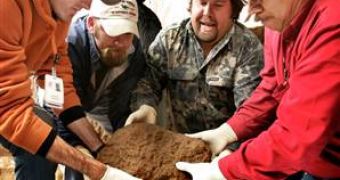A new ground penetrating radar technology allowed the scientists to locate a rare meteorite in a wheat field in Kiowa County, Kansas.
This is the most detailed meteorite excavation yet, with researchers carefully using brushes and hand tools to preserve evidence of the impact trail. The meteorite location in the Pleistocene soil layer gives it an age of 10,000 years. "We know it is recent," said Carolyn Sumners, director of Astronomy at the Houston Museum of Natural Science. "Native Americans could have seen it."
"Fewer than 1 % of the meteorites discovered on earth are pallasite meteorites, known for their crystals embedded in iron," said Philip Mani of Houston Museum.
Sophisticated metal detectors went wrong in discovering pallasite meteorites: what has been thought to be the largest pallasite meteorite ever found proved to be - by the new technique - just a steel cable. But, as the area had about a dozen potential targets, a sizable pallasite was found buried four feet under the ground and situated a quarter of a mile from where the world's largest pallasite meteorite was found a year ago. "The newest find weighs 154 lbs and measures 18 by 12 by 12, which is bigger than most such meteorites but on par for this particular field," said Steve Arnold of Huston Museum.
"What is unique is not the size, but the fact it was found in context," said Patricia Reiff, director of the Rice Space Institute.
Ground-penetrating technology proved for the first time that it could be used to locate objects found deep in the ground and to achieve an accurate three-dimensional image of them. "It validates the technique so we can use something similar to that instrument when we go to Mars," Reiff said.
Similar systems were used in the past to locate smaller meteorites in Antarctica where ice is easier to penetrate by the sonar. Till this dig, the technology had not been successfully instrumented for detection in heavy soils - like what is the case of Mars - to encounter meteorites or water there. "When we find a piece of meteorite, each one is a new sentence we add to the book to understand the evolution of the solar system," said Essam Heggy, planetary scientist at the Johnson Space Center's Lunar and Planetary Institute in Houston.
The Brenham meteorite field, where the diggings were made and to whom those pallasite belong, was discovered in 1882. Meteorite pieces were found as far away as Indian mounds in Ohio, showing that meteorites stones were used as jewelry and ceremonial artifacts. The site has been overlooked by scientists till recently, when Arnold and Mani leased eight square miles of it and began looking underground with new technology. "More than 15,000 pounds of meteorites have been recovered from the Brenham fall, with about a third of them found by the two men in the past year," Mani said. And this means almost 40 meteorites pulled from the field by their Brenham Meteorite Co.
Photo credit: Charlie Riedel

 14 DAY TRIAL //
14 DAY TRIAL //